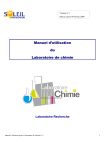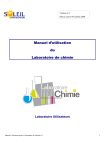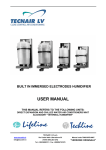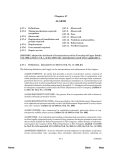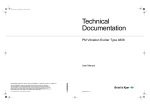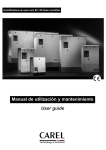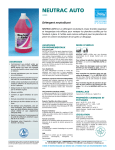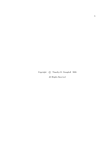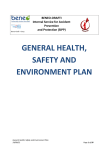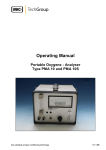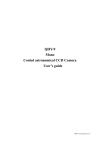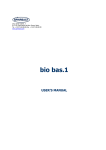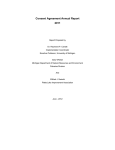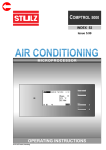Download Manuel utilisation chimie_ Version 4 ENG
Transcript
Version n°4 Updated on 9th October 2008 Chemistry Laboratory Users’ Manual Users’ Laboratory Chemistry Laboratory Users’ Manual n° 1 1 1 Summary 1 Summary..................................................................................................................................................................... 2 2 Foreword..................................................................................................................................................................... 3 3 Presenting the Laboratory............................................................................................................................................ 4 4 3.1 To whom does this apply?........................................................................................................................... 4 3.2 Services........................................................................................................................................................ 4 3.3 Equipment.................................................................................................................................................... 4 Safety rules ................................................................................................................................................................. 6 4.1 General instructions..................................................................................................................................... 6 4.2 Chemical risks ............................................................................................................................................. 7 4.2.1 General remarks.................................................................................................................................. 7 4.2.2 Acids, bases and solvents ................................................................................................................... 7 4.2.3 CMR (CARCINOGENIC, MUTAGENIC, REPROTOXIC) products ............................................. 7 4.3 Measures to take in case of incidents .......................................................................................................... 8 4.3.1 In case of an accident to the person.................................................................................................... 8 4.3.2 In case of a fire alarm. ........................................................................................................................ 8 4.3.3 In case of an environmental incident.................................................................................................. 9 5 6 Experimental follow-up procedures ............................................................................................................................. 9 5.1 E-log or computerized log book of experiments ......................................................................................... 9 5.2 Data storage ................................................................................................................................................. 9 Appendices ............................................................................................................................................................... 10 6.1 Simplified glove compatibility table ......................................................................................................... 10 6.2 Hazard signs .............................................................................................................................................. 11 Chemistry Laboratory Users’ Manual n° 1 2 2 Foreword The aim of this document, compiled for laboratory users, is to present all the preventative measures that must be applied when working in the chemistry laboratory. It contains all the elements required to understand and take the necessary precautions when using the laboratory and has user autonomy as its objective. The laboratory staff consists of: Head of department: Stéphanie Blanchandin Health and safety officer Tel: ++33(0)1 69 35 96 85 Fax: ++33(0)1 69 35 94 56 E-mail: [email protected] Assistant Engineer: Karine Chaouchi Tel: ++33(0)1 69 35 97 40 Fax: ++33(0)1 69 35 94 56 E-mail: [email protected] The Users’ Chemistry Laboratory is located in: Synchrotron building O3-0-02 Chemistry Laboratory Users’ Manual n° 1 3 3 Presenting the Laboratory 3.1 To whom does this apply? This applies to all laboratory users. 3.2 Services The laboratory provides the infrastructure, equipment and products normally found in a chemistry laboratory and its technical staff offer scientific support (advice/expertise) and technical support (feasibility/setting up of experiments). The following Individual Protection Equipment (IPE) is provided for use in the laboratory: lab coats, gloves, glasses and masks. During normal office hours, external/internal users are invited to contact laboratory staff for any requests (chemicals, small materials, sample and/ or material storage etc.), and the local beamline contact (for declared projects) outside normal hours. 3.3 Equipment Simplified Operating Methods for all equipment are available on the OM link. A paper version is also available in the laboratory and the original manuals can be consulted on request. Equipment present in the laboratory is listed in alphabetical order: 1. Stirrers 2. Thermostated bath 3. Balances (1/10 mg) 4. Basic glove box (N2 gas system) 5. Centrifuge 6. Conductimeter 7. Ultrasonic washer 8. Desiccators 9. Turbidimeter 10. Ultrapure water 11. Oven 12. Glassware washer 13. Mixers 14. Micropipettes 15. Binocular microscope 16. Mortars 17. 18. 19. 20. 21. 22. 23. 24. 25. 26. 27. 28. 29. 30. 31. 32. Ventilated cabinet for solvents Ventilated cabinet for acids/bases pH-meter Hot plate Vacuum pump Pellet equipment/press Fridge/freezer Fume cupboard Sieve Vacuum filtration device Glassware Vortex mixer DSC (in collaboration with SAMBA) Raman microscope Raman spectrometer (in collaboration with SAMBA) UV-Vis spectrometer (in collaboration with SAMBA) The following plan shows where the equipment is distributed in the laboratory, as well as the product storage areas and the areas designated for sorting the different kinds of waste resulting from the experiments. Chemistry Laboratory Users’ Manual n° 1 4 N2 He Ar 2 8 11 29 26 21 19 14 25 22 16 4 7 1,20,28 9 3 10 12 15 6 32 27 24 17 3 31 24 23 18 30 Plastic box: needles 5 L plastic container : solvent waste 5 L plastic container: base waste 5 L plastic container: acid waste 60 L plastic container : glass waste 30 L plastic container: contaminated waste (gloves, paper, etc.) Chemistry Laboratory Users’ Manual n° 1 5 4 Safety rules 4.1 General instructions Access: Access to the laboratory is only permitted after authorization from a member of the laboratory staff. A badge system with controlled access is in place. The laboratory is open 24 hours on request for all users with green classified projects. For yellow or red classified projects, specific procedures will be set up on an individual basis. Individual protection: • • • Lab coats must be worn in the laboratory. Minimum safety protection: o Gloves suitable for the product being used (See Appendix 6.1) : For handling ketone-type solvents: latex gloves. When using acids or bases in concentrated solutions or CMR products (carcinogenic, mutagenic or reprotoxic): nitrile gloves When wearing gloves, they must be removed before using the phone, when going anywhere requiring the opening of doors and before using computer keyboards, handling books or papers, etc. o Protective glasses against splashes when using liquid nitrogen or irritants, toxic or carcinogenic products. Special glasses for use with lasers. o Wearing a type FFP3 mask when handling aerosols with liquid or toxic particles. Masks with filter cartridges are available on request, for use when handling gases and toxic vapours. Those carrying out experiments must wash their hands before and after handling all chemicals. Recommendations on how to handle materials: • • • • It is forbidden to handle dangerous chemicals when alone in the laboratory. Pipetting using the mouth is strictly forbidden! Manual pipetting devices are provided. Single-use materials are preferable whenever possible. All samples and chemical products must be labelled. The label must contain the following information: name of the product and date of preparation, and how dangerous it is. The name of the project and a contact name should also be included. • Except in specific cases, all users must leave with all their samples securely packaged. • Please refer to user manuals for all equipment required for the experiment and follow instructions concerning their use, maintenance and safety. • Every day, after handling all chemical samples, the laboratory should be returned to its original state: all chemicals and samples should be put away , all work surfaces should be cleaned, etc Work premises: • • • • • • IT IS STRICTLY FORBIDDEN TO EAT, DRINK OR SMOKE in the laboratory. Do not place food in the laboratory refrigerator. Do not wash dishes used for food in the laboratory sink. Clean your work area before leaving. Chemical storage areas are marked. Chemical waste must be placed in the designated bins. Chemistry Laboratory Users’ Manual n° 1 6 • 4.2 Needles must be systematically thrown away in the special containers provided. NEVER put the top back on a needle (throw tops away in ordinary waste bin). Chemical risks 4.2.1 General remarks • • • • • • All dangerous chemicals must be handled in the fume cupboard. All caustic, irritant and CMR (carcinogenic, mutagenic, reprotoxic) products must be handled inside the fume cupboard with gloves suitable for the product concerned and with the lab coat buttoned up for maximum protection. Work carried out away from the fume cupboard can only involve substances without risk (without hazard signs). In this case, it is still recommended that protective glasses be worn against splashes and a FFP3 mask to protect against dust particles. When a new flask or bottle is opened for the first time, mark with the date of opening. All flasks and bottles must be labelled. Avoid moving these products around unnecessarily. Clean the balance with the paintbrush and leave the bench clean. 4.2.2 Acids, bases and solvents Storage • • • • None of these products must be stored in the freezer. The storage of these products is reduced to a minimum in relation to laboratory needs. Products in use are placed in the fume cupboard and in the permanently ventilated chemicals cabinet. After use in the fume cupboard, they must be returned to their place in these cabinets. Handling • • Always handle these products in the fume cupboard. Never handle these products near a heat source. Waste disposal • Do not mix products when their interactions or incompatibility are unknown. • Follow the waste disposal procedure and separate each type of chemical waste. • Chemical waste must be thrown out in the respective ACID, BASE or SOLVENT bins under or near the fume cupboard. These containers must be closed. Before closing the bins, check for the absence of chemical reactions. If an exothermic reaction starts or gas is given off, place the open bin in the fume cupboard and pull down the glass protective screen. 4.2.3 CMR (CARCINOGENIC, MUTAGENIC, REPROTOXIC) products Storage • • • Only limited quantities must be ordered. Flasks must be either double packaged or placed on a retention tray. The storage area must be kept to the minimum. There must be limited access to areas containing these products, which should be labelled, and identified as “CMR” with Toxic/Harmful hazard signs. Chemistry Laboratory Users’ Manual n° 1 7 Handling: • • • • • INHALING ANY PRODUCT IN POWDER FORM MUST BE AVOIDED AT ALL COSTS, ESPECIALLY IF IT IS VERY DUSTY: IT IS OBLIGATORY TO WEAR A SPECIALLY ADAPTED FPP3 MASK. The handling of this type of product is limited to people who have had formal training on the risks involved. Pregnant women are forbidden from handling these products or from access to the handling areas. In the case of a very dusty powder, stop the fume cupboard extractor. Do not weigh out the product but use the double weighing system (the weight of the empty container is subtracted from the weight of the product in the container) or use pre-weighed products. It is preferable to use single-use glassware and other utensils. When this is not practicable, it is possible to obtain material required for use just with these products. The experimenter must then wash this equipment him/herself, which will have been labelled “CMR” with Toxic/Harmful signs. The first rinsing water of this equipment is disposed of as chemical waste. Waste disposal: • 4.3 A special procedure is necessary for the disposal of these products. Please ask a member of the chemical laboratory staff. Measures to take in case of incidents All incidents must be reported to the Safety Team. 4.3.1 In case of an accident to the person In all cases: • • First, contact one of the emergency staff listed on the walls of buildings next to the red telephones in the corridor. Otherwise, use the red telephones or dial 18 on a landline phone. The call will connect to the Safety PC in the control room, where it will be treated. For accidents involving mainly chemicals: • • • • • If there are burns over a large area of the body, rinse yourself under the safety shower. For chemical burns, remove contaminated clothes and spray the area thoroughly with water until the arrival of emergency staff. For thermal-type burns, run cold water over the affected area, preferably for at least 5 minutes. If the eyes are affected, use the eye bath. If contact lenses were being worn, do not remove them. In all cases, consult a doctor. 4.3.2 In case of a fire alarm. • When a fire alarm has been set off, o Leave the premises after making the laboratory safe (e.g.: switch off the emergency electricity switch, close hoods, doors and windows). o Leave by the nearest exit following the emergency evacuation plan displayed in the corridors and make your way to the nearest assembly point, then wait for instructions from the safety officers or competent authorities (firemen). Chemistry Laboratory Users’ Manual n° 1 8 o The Head of department is at the disposal of the emergency services for any further information. If you witness the start of a fire, first try to put out the fire with a fire extinguisher, without taking any risks, then alert the authorities by using the red telephones or by dialling 18 on a landline phone. 4.3.3 In case of an environmental incident Spillage of a chemical In case of a chemical spill, use the absorbent material available in the laboratory and limit access to the area of the spill. 5 Experimental follow-up procedures 5.1 E-log or computerized log book of experiments All users of the laboratory are required to enter a minimum of information on the E-Log (still being installed) even if there just to store away products. 5.2 Data storage At present the laboratory is not in a position to store data. We only have the computer hard disks that are wiped clean on a regular basis, so it is preferable if each user takes responsibility for saving his/her own data. Chemistry Laboratory Users’ Manual n° 1 9 6 Appendices 6.1 Simplified glove compatibility table Natural latex Nitrile Neoprene Solvents - + + Ketones + - + Caustic products + + + Acids + + + Hydrocarbons - + + Oils - + + Grease - + Organic solvents - + ++ Excellent + Good = Moderate - Not recommended Chemistry Laboratory Users’ Manual n° 1 + 10 6.2 Hazard signs flammable F Corrosive C Explosive E Dangerous to the environment N This symbol is for flammable products, so these should be used well away from flames or heat. This symbol is for corrosive products that attack living tissues and materials. This symbol is for products capable of exploding on impact or when exposed to a heat source. This symbol is for products harmful to the environment, so they should be salvaged after use for treatment (e.g. organic solvents) Oxidizing agent O This symbol is for oxidizing agents, they help combustion, so must be used far from flames or heat source. Toxic T This symbol is for toxic products; they can cause death in small doses and must be handled using the appropriate protection. Irritant or Harmful: Xi and Xn Chemistry Laboratory Users’ Manual n° 1 This symbol is for irritant or harmful products that can affect the health. They must be handled with the appropriate protection. 11 I, the undersigned ………………........., acknowledge having read the present document and confirm that I : - am aware of the rules and regulations on the running of the chemistry laborator(y)(ies) and - shall follow the procedures described in the user’s manual. Signature: Chemistry Laboratory Users’ Manual n° 1 Date: 12












